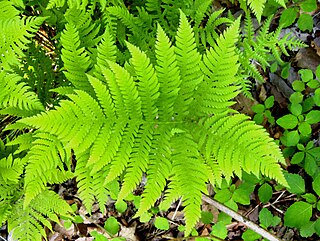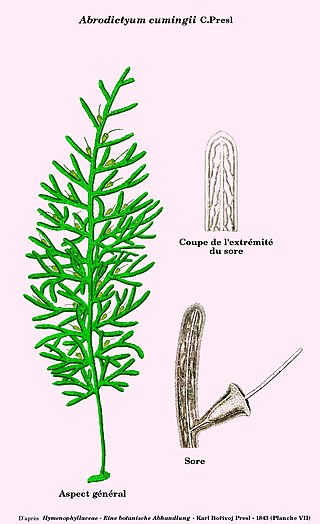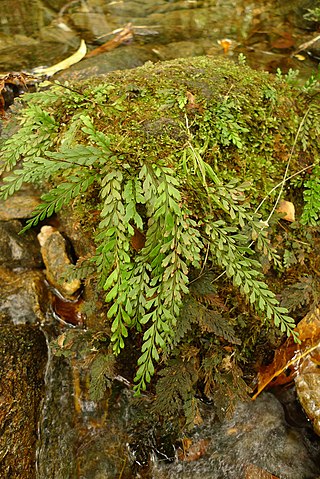
Phegopteris is a genus of ferns in the family Thelypteridaceae, subfamily Phegopteridoideae, in the Pteridophyte Phylogeny Group classification of 2016. They are known collectively as the beech ferns. Species are native to Asia, North America and Europe.

Huperzia is a genus of lycophyte plants, sometimes known as the firmosses or fir clubmosses; the Flora of North America calls them gemma fir-mosses. This genus was originally included in the related genus Lycopodium, from which it differs in having undifferentiated sporangial leaves, and the sporangia not formed into apical cones. The common name firmoss, used for some of the north temperate species, refers to their superficial resemblance to branches of fir (Abies), a conifer. As of 2020, two very different circumscriptions of the genus were in use. In the Pteridophyte Phylogeny Group classification of 2016, Huperzia is one of three genera in the subfamily Huperzioideae of the family Lycopodiaceae. Most species in the subfamily are placed in the genus Phlegmariurus. Huperzia is left with about 25 species, although not all have been formally transferred to other genera. Other sources recognize only Huperzia, which then has about 340 species.

Diphasiastrum is a genus of clubmosses in the plant family Lycopodiaceae. In the Pteridophyte Phylogeny Group classification of 2016, it is placed in the subfamily Lycopodioideae. It is closely related to the genus Lycopodium, and some botanists treat it within a broad view of that genus as a section, Lycopodium sect. Complanata. Some species superficially resemble diminutive gymnosperms and have been given common names such as ground-pine or ground-cedar.

Cyrtomium is a genus of about 35 species of ferns in the family Dryopteridaceae, subfamily Dryopteridoideae, according to the Pteridophyte Phylogeny Group classification of 2016. Species are native to Asia, Africa, and the Pacific Ocean islands (Hawaii). It is very closely related to the genus Polystichum, with 2016 research suggesting it should be included in a clade sister to Polystichum s.s.

Blechnaceae is a family of ferns in the order Polypodiales, with a cosmopolitan distribution. Its status as a family and the number of genera included have both varied considerably. In the Pteridophyte Phylogeny Group classification of 2016, the family has 24 genera, and excludes genera placed in the separate family Onocleaceae. The family is divided into three subfamilies, including Blechnoideae s.s. Alternatively, the entire family may be treated as the subfamily Blechnoideae s.l. of a very broadly defined family Aspleniaceae, and include genera others place in Onocleaceae.

Dennstaedtiaceae is one of fifteen families in the order Polypodiales, the most derived families within monilophytes (ferns). It comprises 10 genera with ca 240 known species, including one of the world's most abundant ferns, Pteridium aquilinum (bracken). Members of the order generally have large, highly divided leaves and have either small, round intramarginal sori with cup-shaped indusia or linear marginal sori with a false indusium formed from the reflexed leaf margin. The morphological diversity among members of the order has confused past taxonomy, but recent molecular studies have supported the monophyly of the order and the family. The reclassification of Dennstaedtiaceae and the rest of the monilophytes was published in 2006, so most of the available literature is not updated.

Hymenophyllum is a genus of ferns in the family Hymenophyllaceae. Its name means "membranous leaf", referring to the very thin translucent tissue of the fronds, which gives rise to the common name filmy fern for this and other thin-leaved ferns. The leaves are generally only one cell thick and lack stomata, making them vulnerable to desiccation. Consequently, they are found only in very humid areas, such as in moist forests and among sheltered rocks. They are small and easy to overlook.

Microgramma is a genus of ferns in the family Polypodiaceae, subfamily Polypodioideae, according to the Pteridophyte Phylogeny Group classification of 2016 (PPG I). They are commonly known as vine ferns or snakeferns.

Hypolepis (beadfern) is a genus of ferns described as a genus in 1806. The word is derived from Greek, meaning "under scale". It is found in tropical and subtropical regions, primarily in the New World but also in the Old World and on various oceanic islands.

Lindsaea, common name necklace fern, is a genus of around 180 species of fern, 15 of which reach Australia. The name is in honour of surgeon John Lindsay of Jamaica. The genus is sometimes spelt Lindsaya.

Christella is a genus of around 70-80 species of ferns in the subfamily Thelypteridoideae of the family Thelypteridaceae in the Pteridophyte Phylogeny Group classification of 2016. Other sources sink Christella into a very broadly defined genus Thelypteris. The genus was named after Konrad H. Christ, a Swiss botanist. The distribution of these plants is mostly in the tropics and sub tropical areas. An Australian example is C. dentata.
Dasygrammitis is a genus of ferns in the family Polypodiaceae, subfamily Grammitidoideae, according to the Pteridophyte Phylogeny Group classification of 2016 (PPG I). It is known from Sri Lanka through southeast Asia and the Philippines to Polynesia.
Archigrammitis is a genus of ferns in the family Polypodiaceae, subfamily Grammitidoideae, according to the Pteridophyte Phylogeny Group classification of 2016 (PPG I). It is known from Malesia and Polynesia.

Abrodictyum is a fern genus in the family Hymenophyllaceae. The genus is accepted in the Pteridophyte Phylogeny Group classification of 2016 but not by some other sources, which sink it into a broadly defined Trichomanes.

Palhinhaea is a genus of lycophytes in the family Lycopodiaceae. In the Pteridophyte Phylogeny Group classification of 2016, it is placed in the subfamily Lycopodielloideae. Some sources do not recognize the genus, sinking it into Lycopodiella. Palhinhaea species are widespread in the tropics and subtropics.

Austrogramme is a genus of ferns in the subfamily Pteridoideae of the family Pteridaceae.

Telmatoblechnum is a genus of ferns in the family Blechnaceae, subfamily Stenochlaenoideae.

Parapolystichum is a genus of ferns in the family Dryopteridaceae, subfamily Elaphoglossoideae, in the Pteridophyte Phylogeny Group classification of 2016. The genus is mainly native to the tropics, although its range extends to southeastern Australia.

Asplenium gracillimum is a fern species native to Australia and New Zealand, also found in Stewart Island and the Chatham Islands. The specific epithet gracillimum refers to the slender and graceful appearance of this fern.

Patrick John Brownsey is a British-born botanist specialising in the systematics of New Zealand ferns, and was for 44 years Curator of Botany at the National Museum of New Zealand and Te Papa.

















